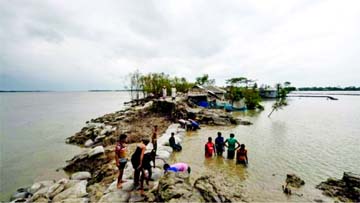
News Desk :
Millions of people across Bangladesh are taking stock of the devastation left by Cyclone Amphan.
A massive clean-up operation has begun after the storm left dozens dead and flattened homes, uprooted trees and left cities without power.
Authorities had evacuated millions of people before the storm struck.
There are reports of tens of thousands of homes damaged or destroyed and many villages submerged by storm surges in low-lying coastal areas like Khulna and Satkhira.
It is the first super cyclone to form in the Bay of Bengal since 1999. Though its winds had weakened by the time it struck, it was still classified as a very severe cyclone.
The affected areas include the Sunderbans, mangroves spread over an area of more than 10,000 square kilometres that spans both
India and Bangladesh – the swampy islands are home to more than four million of the world’s poorest people.
Those in the Sunderbans say it is too early to estimate casualties in the area, which is now cut-off from the mainland by the storm.
“There are houses which have collapsed and people could be trapped in them but we don’t know yet,” Debabrat Halder, who runs an NGO in one of the villages, told the media.
He recalls cyclone Bulbul in November 2019, which was followed by a huge incidence of fever, diarrhoea and flu, and is afraid that that the same may happen again.
And worse, he adds, is that the flooding from contaminated sea water, has likely destroyed the soil.
“Nothing will grow in this soil,” he says, adding that it will likely take years to convert it into fertile land again.

